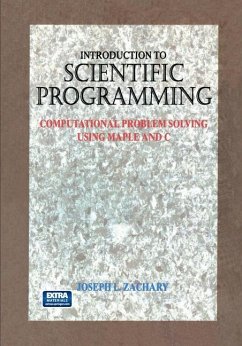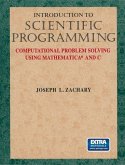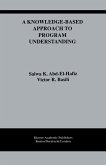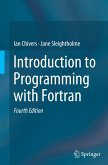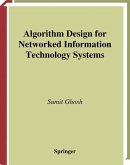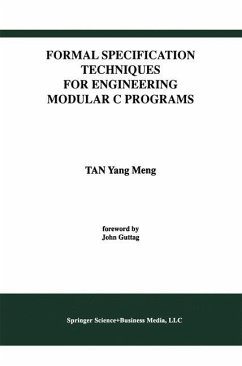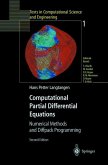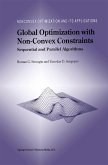Joseph L. Zachary
Introduction to Scientific Programming
Computational Problem Solving Using Maple and C
Joseph L. Zachary
Introduction to Scientific Programming
Computational Problem Solving Using Maple and C
- Broschiertes Buch
- Merkliste
- Auf die Merkliste
- Bewerten Bewerten
- Teilen
- Produkt teilen
- Produkterinnerung
- Produkterinnerung
"Introduction to Computational Science" was developed over a period of two years at the University of Utah Department of Computer Science in conjunction with the U.S. Department of Energy-funded Undergraduate Computation in Engineering Science (UCES) program. Each chapter begins by introducing a problem and then guiding the student through its solution. The computational techniques needed to solve the problem are developed as necassary, making the motivation for learning the computing alwasy apparent. Each chapter will introduce a single problem that will be used to motivate a single computing…mehr
Andere Kunden interessierten sich auch für
![Introduction to Scientific Programming Introduction to Scientific Programming]() Joseph L. ZacharyIntroduction to Scientific Programming38,99 €
Joseph L. ZacharyIntroduction to Scientific Programming38,99 €![A Knowledge-Based Approach to Program Understanding A Knowledge-Based Approach to Program Understanding]() Salwa K. Abd-El-HafizA Knowledge-Based Approach to Program Understanding77,99 €
Salwa K. Abd-El-HafizA Knowledge-Based Approach to Program Understanding77,99 €![Introduction to Programming with Fortran Introduction to Programming with Fortran]() Ian ChiversIntroduction to Programming with Fortran106,99 €
Ian ChiversIntroduction to Programming with Fortran106,99 €![Algorithm Design for Networked Information Technology Systems Algorithm Design for Networked Information Technology Systems]() Sumit GhoshAlgorithm Design for Networked Information Technology Systems75,99 €
Sumit GhoshAlgorithm Design for Networked Information Technology Systems75,99 €![Formal Specification Techniques for Engineering Modular C Programs Formal Specification Techniques for Engineering Modular C Programs]() Tan Yang MengFormal Specification Techniques for Engineering Modular C Programs115,99 €
Tan Yang MengFormal Specification Techniques for Engineering Modular C Programs115,99 €![Computational Partial Differential Equations Computational Partial Differential Equations]() Hans P. LangtangenComputational Partial Differential Equations39,99 €
Hans P. LangtangenComputational Partial Differential Equations39,99 €![Global Optimization with Non-Convex Constraints Global Optimization with Non-Convex Constraints]() Roman G. StronginGlobal Optimization with Non-Convex Constraints113,99 €
Roman G. StronginGlobal Optimization with Non-Convex Constraints113,99 €-
-
-
"Introduction to Computational Science" was developed over a period of two years at the University of Utah Department of Computer Science in conjunction with the U.S. Department of Energy-funded Undergraduate Computation in Engineering Science (UCES) program. Each chapter begins by introducing a problem and then guiding the student through its solution. The computational techniques needed to solve the problem are developed as necassary, making the motivation for learning the computing alwasy apparent. Each chapter will introduce a single problem that will be used to motivate a single computing concept. The notes currently consist of 15 chapters. The first seven chapters deal with Maple and the last eight with C. The textbook will contain 20 to 30 chapters covering a similar mix of concepts at a finer level of detail.
Produktdetails
- Produktdetails
- Verlag: Springer / Springer New York / Springer, Berlin
- Softcover reprint of the original 1st ed. 1996
- Seitenzahl: 408
- Erscheinungstermin: 27. Januar 2014
- Englisch
- Abmessung: 244mm x 170mm x 23mm
- Gewicht: 701g
- ISBN-13: 9781461275183
- ISBN-10: 1461275180
- Artikelnr.: 41326746
- Herstellerkennzeichnung
- Springer-Verlag GmbH
- Tiergartenstr. 17
- 69121 Heidelberg
- ProductSafety@springernature.com
- Verlag: Springer / Springer New York / Springer, Berlin
- Softcover reprint of the original 1st ed. 1996
- Seitenzahl: 408
- Erscheinungstermin: 27. Januar 2014
- Englisch
- Abmessung: 244mm x 170mm x 23mm
- Gewicht: 701g
- ISBN-13: 9781461275183
- ISBN-10: 1461275180
- Artikelnr.: 41326746
- Herstellerkennzeichnung
- Springer-Verlag GmbH
- Tiergartenstr. 17
- 69121 Heidelberg
- ProductSafety@springernature.com
1 Computational Science.- 1.1 Experiment, Theory, and Computation.- 1.2 Solving Computational Problems.- 1.3 Onward.- 2 Population Density: Computational Properties of Numbers.- 2.1 Model.- 2.2 Method.- 2.3 Implementation.- 2.4 Arithmetic Expressions.- 2.5 Rational Numbers in Maple.- 2.6 Rational Number Errors.- 2.7 Floating-Point Numbers in Maple.- 2.8 Floating-Point Number Errors.- 2.9 Assessment.- 2.10 Key Concepts.- 2.11 Exercises.- 3 Eratosthenes: Significant Digits and Interval Arithmetic.- 3.1 Model.- 3.2 Method.- 3.3 Implementation.- 3.4 Implementation Assessment.- 3.5 Method Assessment.- 3.6 Model Assessment.- 3.7 Problem Assessment.- 3.8 Key Concepts.- 3.9 Exercises.- 4 Stairway to Heaven: Accumulation of Roundoff Error.- 4.1 An Inductive Model.- 4.2 Summing the Harmonic Series.- 4.3 Comparing Rational and Floating-Point Arithmetic.- 4.4 Assessment.- 4.5 Key Concepts.- 4.6 Exercises.- 5 Kitty Hawk: Programmer-Defined Functions.- 5.1 Model.- 5.2 Method.- 5.3 Implementation.- 5.4 Assessment.- 5.5 Key Concepts.- 5.6 Exercises.- 6 Baby Boom: Symbolic Computation.- 6.1 Simple Interest.- 6.2 Compound Interest.- 6.3 Continuous Interest.- 6.4 Assessment.- 6.5 Key Concepts.- 6.6 Exercises.- 7 Ballistic Trajectories: Scientific Visualization.- 7.1 Ballistic Motion.- 7.2 Scientific Visualization.- 7.3 Motion Functions.- 7.4 Two-Dimensional Plots.- 7.5 Multiple-Curve Plots.- 7.6 Parametric Plots.- 7.7 Animation.- 7.8 Key Concepts.- 7.9 Exercises.- 8 The Battle for Leyte Gulf: Symbolic Mathematics.- 8.1 Fixed Trajectory.- 8.2 Arbitrary Trajectories.- 8.3 Effects of Drag.- 8.4 Piecewise Trajectories.- 8.5 Final Assessment.- 8.6 Key Concepts.- 8.7 Exercises.- 9 Old Macdonald's Cow: Procedural Programming.- 9.1 Solving Equations in Maple.- 9.2 Bisection Method.- 9.3 ABisection Procedure.- 9.4 Assessment.- 9.5 Key Concepts.- 9.6 Exercises.- 10 Introduction to C.- 10.1 Maple Background.- 10.2 C Background.- 10.3 An Example C Program.- 10.4 Interpreters versus Compilers.- 10.5 Differences Between Maple and C.- 10.6 Learning C.- 10.7 Eratosthenes's Problem.- 10.8 Kitty Hawk Problem.- 10.9 Key Concepts.- 10.10 Exercises.- 11 Robotic Weightlifting: Straight-Line Programs.- 11.1 Trigonometry of a Link Diagram.- 11.2 Components of a Straight-Line Program.- 11.3 Types.- 11.4 Expressions.- 11.5 Simple Statements.- 11.6 Main Function.- 11.7 Libraries.- 11.8 Assessment.- 11.9 Key Concepts.- 11.10 Exercises.- 12 Sliding Blocks: Conditionals and Functions.- 12.1 A Infinite Ramp without Friction.- 12.2 An Infinite Ramp with Friction.- 12.3 A Finite Ramp with Friction.- 12.4 Programmer-Defined Functions.- 12.5 Assessment.- 12.6 Key Concepts.- 12.7 Exercises.- 13 Rod Stacking: Designing with Functions.- 13.1 Decomposing the problem.- 13.2 Design.- 13.3 Implementation.- 13.4 Assessment.- 13.5 Key Concepts.- 13.6 Exercises.- 14 Newton's Beam: Repetition.- 14.1 Newton's Method.- 14.2 Implementation of Newton's Method.- 14.3 Bisection Method Implementation.- 14.4 Assessment.- 14.5 Key Concepts.- 14.6 Exercises.- 15 Numerical Integration: Multiple-File Programs.- 15.1 Numerical Integration.- 15.2 Rectangular Method.- 15.3 Rectangular Method Implementation.- 15.4 Trapezoidal Method.- 15.5 Trapezoidal Method Implementation.- 15.6 Multiple-File Programs.- 15.7 Comparison of Rectangular and Trapezoidal Methods.- 15.8 Key Concepts.- 15.9 Exercises.- 16 Harmonic Oscillation: Structures and Abstract Datatypes.- 16.1 Newton's Method with Complex Roots.- 16.2 Rod Stacking Revisited.- 16.3 Newton's Method Revisited.- 16.4 Assessment.- 16.5 KeyConcepts.- 16.6 Exercises.- 17 Heat Transfer in a Rod: Arrays.- 17.1 Modeling Heat Flow.- 17.2 A Finite-Element Method.- 17.3 Implementation.- 17.4 Assessment.- 17.5 Key Concepts.- 17.6 Exercises.- 18 Visualizing Heat Transfer: Arrays as Parameters.- 18.1 Arrays as Parameters.- 18.2 File Input.- 18.3 File Output.- 18.4 Assessment.- 18.5 Key Concepts.- 18.6 Exercises.- A Maple Functions and Constants.- B C Library Functions.
1 Computational Science.- 1.1 Experiment, Theory, and Computation.- 1.2 Solving Computational Problems.- 1.3 Onward.- 2 Population Density: Computational Properties of Numbers.- 2.1 Model.- 2.2 Method.- 2.3 Implementation.- 2.4 Arithmetic Expressions.- 2.5 Rational Numbers in Maple.- 2.6 Rational Number Errors.- 2.7 Floating-Point Numbers in Maple.- 2.8 Floating-Point Number Errors.- 2.9 Assessment.- 2.10 Key Concepts.- 2.11 Exercises.- 3 Eratosthenes: Significant Digits and Interval Arithmetic.- 3.1 Model.- 3.2 Method.- 3.3 Implementation.- 3.4 Implementation Assessment.- 3.5 Method Assessment.- 3.6 Model Assessment.- 3.7 Problem Assessment.- 3.8 Key Concepts.- 3.9 Exercises.- 4 Stairway to Heaven: Accumulation of Roundoff Error.- 4.1 An Inductive Model.- 4.2 Summing the Harmonic Series.- 4.3 Comparing Rational and Floating-Point Arithmetic.- 4.4 Assessment.- 4.5 Key Concepts.- 4.6 Exercises.- 5 Kitty Hawk: Programmer-Defined Functions.- 5.1 Model.- 5.2 Method.- 5.3 Implementation.- 5.4 Assessment.- 5.5 Key Concepts.- 5.6 Exercises.- 6 Baby Boom: Symbolic Computation.- 6.1 Simple Interest.- 6.2 Compound Interest.- 6.3 Continuous Interest.- 6.4 Assessment.- 6.5 Key Concepts.- 6.6 Exercises.- 7 Ballistic Trajectories: Scientific Visualization.- 7.1 Ballistic Motion.- 7.2 Scientific Visualization.- 7.3 Motion Functions.- 7.4 Two-Dimensional Plots.- 7.5 Multiple-Curve Plots.- 7.6 Parametric Plots.- 7.7 Animation.- 7.8 Key Concepts.- 7.9 Exercises.- 8 The Battle for Leyte Gulf: Symbolic Mathematics.- 8.1 Fixed Trajectory.- 8.2 Arbitrary Trajectories.- 8.3 Effects of Drag.- 8.4 Piecewise Trajectories.- 8.5 Final Assessment.- 8.6 Key Concepts.- 8.7 Exercises.- 9 Old Macdonald's Cow: Procedural Programming.- 9.1 Solving Equations in Maple.- 9.2 Bisection Method.- 9.3 ABisection Procedure.- 9.4 Assessment.- 9.5 Key Concepts.- 9.6 Exercises.- 10 Introduction to C.- 10.1 Maple Background.- 10.2 C Background.- 10.3 An Example C Program.- 10.4 Interpreters versus Compilers.- 10.5 Differences Between Maple and C.- 10.6 Learning C.- 10.7 Eratosthenes's Problem.- 10.8 Kitty Hawk Problem.- 10.9 Key Concepts.- 10.10 Exercises.- 11 Robotic Weightlifting: Straight-Line Programs.- 11.1 Trigonometry of a Link Diagram.- 11.2 Components of a Straight-Line Program.- 11.3 Types.- 11.4 Expressions.- 11.5 Simple Statements.- 11.6 Main Function.- 11.7 Libraries.- 11.8 Assessment.- 11.9 Key Concepts.- 11.10 Exercises.- 12 Sliding Blocks: Conditionals and Functions.- 12.1 A Infinite Ramp without Friction.- 12.2 An Infinite Ramp with Friction.- 12.3 A Finite Ramp with Friction.- 12.4 Programmer-Defined Functions.- 12.5 Assessment.- 12.6 Key Concepts.- 12.7 Exercises.- 13 Rod Stacking: Designing with Functions.- 13.1 Decomposing the problem.- 13.2 Design.- 13.3 Implementation.- 13.4 Assessment.- 13.5 Key Concepts.- 13.6 Exercises.- 14 Newton's Beam: Repetition.- 14.1 Newton's Method.- 14.2 Implementation of Newton's Method.- 14.3 Bisection Method Implementation.- 14.4 Assessment.- 14.5 Key Concepts.- 14.6 Exercises.- 15 Numerical Integration: Multiple-File Programs.- 15.1 Numerical Integration.- 15.2 Rectangular Method.- 15.3 Rectangular Method Implementation.- 15.4 Trapezoidal Method.- 15.5 Trapezoidal Method Implementation.- 15.6 Multiple-File Programs.- 15.7 Comparison of Rectangular and Trapezoidal Methods.- 15.8 Key Concepts.- 15.9 Exercises.- 16 Harmonic Oscillation: Structures and Abstract Datatypes.- 16.1 Newton's Method with Complex Roots.- 16.2 Rod Stacking Revisited.- 16.3 Newton's Method Revisited.- 16.4 Assessment.- 16.5 KeyConcepts.- 16.6 Exercises.- 17 Heat Transfer in a Rod: Arrays.- 17.1 Modeling Heat Flow.- 17.2 A Finite-Element Method.- 17.3 Implementation.- 17.4 Assessment.- 17.5 Key Concepts.- 17.6 Exercises.- 18 Visualizing Heat Transfer: Arrays as Parameters.- 18.1 Arrays as Parameters.- 18.2 File Input.- 18.3 File Output.- 18.4 Assessment.- 18.5 Key Concepts.- 18.6 Exercises.- A Maple Functions and Constants.- B C Library Functions.

